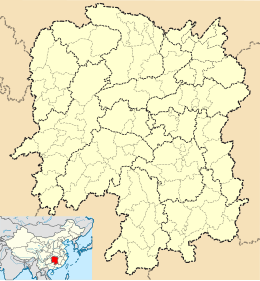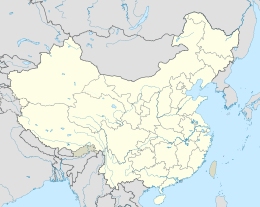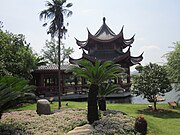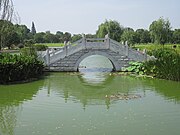|
Orange Isle
Orange Isle (Chinese: 橘子洲; pinyin: Júzi Zhōu) is an isle in Xiang River, Changsha, Hunan, China.[1][2] It also known by other names, such as Ju Isle (橘洲; Jú Zhōu) and Shuilu Isle (水陆洲; 水陸洲; Shuǐlù Zhōu; 'Water-and-land Isle'). It has a length of 5 kilometres (3.1 mi), a width of 40 to 140 metres (130 to 460 ft) and a total area of 370,900 square metres (91.64 acres).[3][4] It was also a national AAAAA (5A) level tourist attraction and a national key scenic spot.[5] History The first known instance of Orange Isle being documented appeared in 305 B.C., during the Yongxing era of the reign of Emperor Hui of Jin during the Jin Dynasty (266–420).[6] During the Tang dynasty (618–907), poet Du Fu wrote a poem Visiting Daolin Temple and Yuelushan Temple (岳麓山道林二寺行; 嶽麓山道林二寺行; yuè lù shān dào lín èr sì xíng), which mentioned Orange Isle. It had been on the list of The Eight Views of Xiaoxiang - River and Sky: Sunset Snow. Orange Isle was opened in 1904, during the late Qing dynasty (1644–1911).[6] From 1911 to 1949, many foreign embassies and consulates were built on the isle.[1][6] During Mao Zedong's early years, he lived in Changsha. He and his friends He Shuheng, Xiao Zisheng, Cai Hesen, Xiao San and Xiang Jingyu would swim in the Xiang River.[7] Since the 2010s, the Orange Isle Music Festival has been hosted on the isle.[8][9][10][11] On 20 December 2009, the Youth Mao Zedong Statue was built on the isle.[12][13] Attractions
GalleryTransportation
References
Bibliography
External linksWikimedia Commons has media related to Orange Isle. |
||||||||||||||||||||||||||||||||||||||||||||||
Portal di Ensiklopedia Dunia











